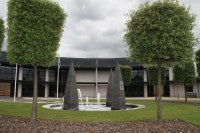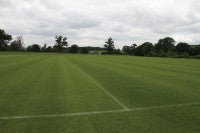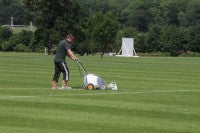Joining Forces
 Originally based on the Welbeck Estate in Nottinghamshire, Welbeck Defence Sixth Form College has provided the Army with many of its future Technical Officers for over fifty years. The college has become one of the UK's top sixth form colleges and has an outstanding academic reputation.
Originally based on the Welbeck Estate in Nottinghamshire, Welbeck Defence Sixth Form College has provided the Army with many of its future Technical Officers for over fifty years. The college has become one of the UK's top sixth form colleges and has an outstanding academic reputation.
In 2004, students destined for the Royal Navy and the Royal Air Force were welcomed and, in 2005, students for the MOD Civil Service attended for the first time.
Welbeck's continued success enabled the Ministry of Defence to invest in a brand new purpose-built site for the college at Woodhouse, near Loughborough in Leicestershire. From 2005, students entering Welbeck joined a state-of-the-art college with the highest quality residential and teaching facilities, benefitting from the latest educational and technological advances.
The college offers a unique programme of personal, physical and intellectual development, which provides students with a rounded education specifically designed to meet the needs of today's modern technical Armed Forces.
The programme for MOD students does not end after a two-year A-level programme: the four Services continue to monitor and support students through university and on to professional training with their respective Armed Service or within the Ministry of Defence Civil Service.
Welbeck College is situated on a thirty-six acre site on the charming rural setting of Charnwood Forest in Leicestershire. The management of the grounds and college facilities is undertaken by Interserve Defence Ltd., on behalf of Minerva Education & Training Ltd., who are the Private Finance Initiative (PFI) consortium, made up from the following companies:
• Interserve Investments - 45%
• HSBC - 45%
• TQ Education & Training - 10%
 Their contract is with the Defence Academy, Shrivenham, to build, maintain and deliver services at the college.
Their contract is with the Defence Academy, Shrivenham, to build, maintain and deliver services at the college.
Interserve deliver all services in-house by the use of directly employed labour, with grounds maintenance services being the exception to this. Gavin Jones Ltd. were employed in 2005 on a 3+2 year contract and is currently putting in a tender to continue working at the site.
They employ four staff to oversee all the day to day grounds maintenance operations at the college. Paul Wright is the company's technical service manager who oversees a number of contracts in the Midlands and North of England.
Paul liaises with Joe O'Halloran, the Operations Manager for Interserve. They meet on a regular basis to discuss and plan work, especially overseeing the third party events held at the college's facilities leased out during holiday periods. A number of top flight sports clubs, including Leicester Tigers RUFC and Leicester City FC, have started to hire the facilities due to the high quality of pitches and the superb accommodation that is readily available during the college holidays.

Paul and Joe have formed a great partnership, especially useful recently as they had to deal with a number of contractors and consultants when rectifying drainage problems that manifested from the original sportsfield constructions, where stones were found in the top 100mm of the surface and parts of the playing fields were not draining adequately.
Interserve took the initiative to reconstruct all of the winter sportsfields and, at the same time, installing an integral irrigation system to all pitches. The company employed the services of Turf Trax GMS as consultants (Alex Vickers and Dr Richard Earl) and Rob Kendle of ATB Sports Solutions as the construction contractor, who undertook a two year programme of works:
• Killing of old pitch surface by use of herbicide
• Removal of old pitch surface by use of a Koro Field Top Maker to an approximate depth of 20-25mm
• Removal of exposed surface stone by mechanical and hand picking
• Ground breaking of area in two diagonal passes
• Installation of bank cut off drains, 150mm perforated pipe laid to falls, and back filled to exposed surface with 6mm granite chippings (dust free)
• Gravel bands cut at 1m centres, 40 x 350mm depth, filled 50% with 6mm granite chippings (dust free) and then topped up with 70/30 rootzone
• Lateral drainage at 5m centres. Cut to 60mm depth - 100mm perforated pipe filled to with 6mm granite chippings (dust free)
• Main field drainage laid to falls, 150mm perforated pipe, back filled with granite chippings and finished with rootzone
• Mansfield Sand 70/30 rootzone levelled to a depth of 60mm across the full pitch area and run off
• The pitches were seeded in two passes at a rate of 35g/m2
• Installation of irrigation infrastructure, and new 100m3 sectional irrigation water tank and associate telemeter monitoring to the Trend Building Management system in the operations manager's office
 All excavation material and arisings were re-used on site to create a training area for the college's Combined Cadet Force, which provides the college with a unique additional cadet training facility.
All excavation material and arisings were re-used on site to create a training area for the college's Combined Cadet Force, which provides the college with a unique additional cadet training facility.
The work has been very successful, with the newly refurbished playing surfaces, which have been rated by visitors, including 3rd party users, as being very high quality, certainly at county, if not regional, level.
The college boasts two cricket squares, four senior football and five senior rugby pitches, with a number of other pitches that accommodate other sports and activities. The college also has a large assault course and a number of artificial pitches for tennis and hockey. A full size, 400m, six lane athletic track is marked out on the grass in the summer to complement the long jump, high jump, javelin and discus areas.
Mowing regimes
Grass areas are mown on a weekly basis, with the cricket square being mown two or three times a week when grass growth is excessive. Prepared cricket pitches are mown to 5mm for play. All formal lawns and cricket squares are boxed mown, cutting between 10-20mm in the growing season and between 25-40mm in the winter months.
Fo otball pitches are mown between 25-35mm all year round using ride on triple cylinder mowers, whilst the rugby pitches are cut with rotary mowers between 40-60mm.
otball pitches are mown between 25-35mm all year round using ride on triple cylinder mowers, whilst the rugby pitches are cut with rotary mowers between 40-60mm.
There are various rough style grass areas that provide wildlife corridors, linking tree plantations and demarcating perimeter areas around the sportsfields. These are cut using rotary and flail mowers as required - medium rough is kept at between 75-150mm, whilst the long rough is kept between 100-300mm. Some areas are managed for wild flowers, and maintained on a cut and collect regime once a year.
Formal lawn areas also receive additional work in terms of renovation, feeding and weeding programmes. They are scarified in the spring and are fed and treated with selective herbicides to control weed growth.
The complete cycle of grass cutting usually takes around three or four days, depending on growth and time of the year.
All the pitches are marked, using a spray jet line marker, on a weekly basis, string lines are used to ensure lines are kept straight and accurate.
End of season work, for winter games pitches and cricket outfield areas, usually consists of mowing down the sward, applying a fertiliser, vertidraining, topdressing and overseeding.
The work is carried out during the spring period when the pitches are mown to 15mm, vertidrained using 19mm diameter tines at 125 x 100mm spacings to a depth of 150mm with some heave.
A 70/30 rootzone topdressing is applied - 60 tonnes for football, 80 tonnes for rugby and 30 tonnes for the cricket outfields. A selected approved grass seed mixture is then sown in two passes at a rate of 20 grammes per m2.
 Autumn maintenance of the cricket squares consists of scarifying in several directions to remove thatch and surface debris, repairing ends, reseeding and topdressing with Boughton loam. Seed used is based on a 60% dwarf ryegrass mixture, 35% chewings fescue and 5% bent grasses.
Autumn maintenance of the cricket squares consists of scarifying in several directions to remove thatch and surface debris, repairing ends, reseeding and topdressing with Boughton loam. Seed used is based on a 60% dwarf ryegrass mixture, 35% chewings fescue and 5% bent grasses.
During the winter period, the square is mown with rotary mowers between 20-25mm.
Paul and his staff are also responsible for maintaining all the trees, hedges and shrub beds on site, undertaking a robust programme of weeding, pruning, hedge cutting, thinning and crown lifting to keep them in good order. The college also has a number of eco-friendly green roof areas, which are attractive sedum sown roof spaces. These require a limited six monthly servicing regime
There are a number of high quality shrub/flower beds that require a high level of maintenance, with specific attention made to pruning the shrubs properly to encourage flowering and form.
It is, without doubt, a very busy site which keeps both Gavin Jones and Interserve fully occupied, with some exacting timescales and standards to maintain in terms of service delivery. Paul is very pleased with the results of their input in keeping the site functional and up to standard. He surely hopes that their new bid to secure the contract for the next term of office is a successful one.
